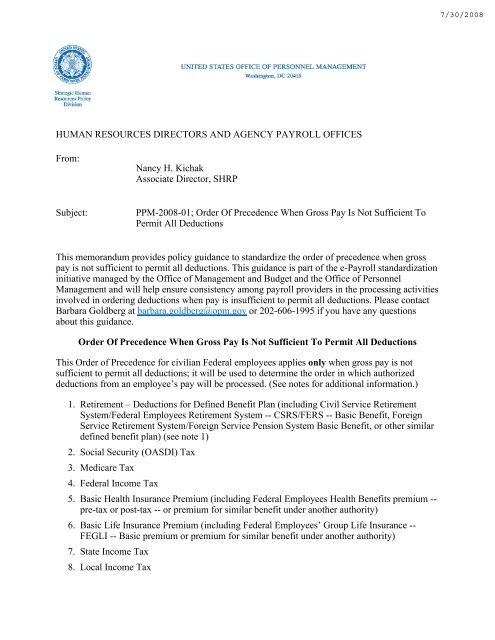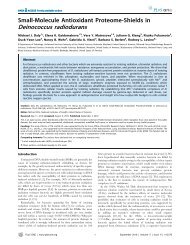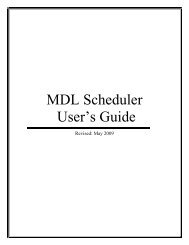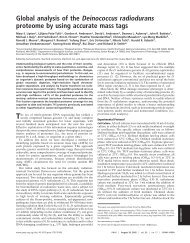Pay Deductions Order of Precedence
Pay Deductions Order of Precedence
Pay Deductions Order of Precedence
You also want an ePaper? Increase the reach of your titles
YUMPU automatically turns print PDFs into web optimized ePapers that Google loves.
HUMAN RESOURCES DIRECTORS AND AGENCY PAYROLL OFFICESFrom:Nancy H. KichakAssociate Director, SHRPSubject:PPM-2008-01; <strong>Order</strong> Of <strong>Precedence</strong> When Gross <strong>Pay</strong> Is Not Sufficient ToPermit All <strong>Deductions</strong>This memorandum provides policy guidance to standardize the order <strong>of</strong> precedence when grosspay is not sufficient to permit all deductions. This guidance is part <strong>of</strong> the e-<strong>Pay</strong>roll standardizationinitiative managed by the Office <strong>of</strong> Management and Budget and the Office <strong>of</strong> PersonnelManagement and will help ensure consistency among payroll providers in the processing activitiesinvolved in ordering deductions when pay is insufficient to permit all deductions. Please contactBarbara Goldberg at barbara.goldberg@opm.gov or 202-606-1995 if you have any questionsabout this guidance.<strong>Order</strong> Of <strong>Precedence</strong> When Gross <strong>Pay</strong> Is Not Sufficient To Permit All <strong>Deductions</strong>This <strong>Order</strong> <strong>of</strong> <strong>Precedence</strong> for civilian Federal employees applies only when gross pay is notsufficient to permit all deductions; it will be used to determine the order in which authorizeddeductions from an employee’s pay will be processed. (See notes for additional information.)1.2.3.4.5.6.7.8.Retirement – <strong>Deductions</strong> for Defined Benefit Plan (including Civil Service RetirementSystem/Federal Employees Retirement System -- CSRS/FERS -- Basic Benefit, ForeignService Retirement System/Foreign Service Pension System Basic Benefit, or other similardefined benefit plan) (see note 1)Social Security (OASDI) TaxMedicare TaxFederal Income TaxBasic Health Insurance Premium (including Federal Employees Health Benefits premium --pre-tax or post-tax -- or premium for similar benefit under another authority)Basic Life Insurance Premium (including Federal Employees’ Group Life Insurance --FEGLI -- Basic premium or premium for similar benefit under another authority)State Income TaxLocal Income Tax
9.Collection <strong>of</strong> Debts Owed to the U.S. Government (e.g., tax debt, salary overpayment,failure to withhold proper amount <strong>of</strong> deductions, advance <strong>of</strong> salary or travel expenses, etc.;debts which may or may not be delinquent; debts which may be collected through theTreasury Offset Program, an automated centralized debt collection program for collectingFederal debt from Federal payments) (see note 2)a. Continuous Levy under the Federal <strong>Pay</strong>ment Levy Program (tax debt)b. Salary Offsets (whether involuntary under 5 U.S.C. 5514 or similar authority orrequired by a voluntarily signed written agreement; if multiple debts are subject tosalary <strong>of</strong>fset, the order is based on when each <strong>of</strong>fset commenced—with earliestcommencing <strong>of</strong>fset at the top <strong>of</strong> the order—unless there are special circumstances, asdetermined by the paying agency)10.11.Court-<strong>Order</strong>ed Collection/Debta. Child Support (may include attorney and other fees as provided for in 5 CFR 581.102(d)) (see note 3) If there are multiple child support orders, the priority <strong>of</strong> orders isgoverned by 42 U.S.C. 666(b) and implementing regulations, as required by 42U.S.C. 659(d) (2).b. Alimony (may include attorney and other fees as provided for in 5 CFR 581.102(d))If there are multiple alimony orders, they are prioritized on a first-come, first-servedbasis, as required by 42 U.S.C. 659(d) (3).c. Bankruptcy (see note 4)d. Commercial GarnishmentsOptional Benefits (see note 5)a. Health Care/Limited-Expense Health Care Flexible Spending Accounts (pre-taxbenefit under FedFlex or equivalent cafeteria plan)b. Dental (pre-tax benefit under FedFlex or equivalent cafeteria plan)c. Vision (pre-tax benefit under FedFlex or equivalent cafeteria plan)d. Health Savings Account (pre-tax benefit under FedFlex or equivalent cafeteria plan)e. Optional Life Insurance Premiums (FEGLI optional benefits or similar benefits underother authority)f. Long-Term Care Insurance Premiumsg. Dependent-Care Flexible Spending Accounts (pre-tax benefit under FedFlex orequivalent cafeteria plan)h. Thrift Savings Plan (TSP)1. Loan <strong>Pay</strong>ments2. Basic Contributions3. Catch-up Contributionsi.Other Optional Benefits12.Other Voluntary <strong>Deductions</strong>/Allotmentsa. Military Service Depositsb. Pr<strong>of</strong>essional Associations
c. Union Duesd. Charitiese. Bondsf. Personal Account Allotments (e.g., to savings or checking accountg. Additional Voluntary <strong>Deductions</strong> (on first-come, first-served basis)13.IRS Paper LeviesNOTES:1.2.Re-employed Annuitant Salary Offset: Salary <strong>of</strong>fset for re-employed annuitants is notincluded in this order <strong>of</strong> precedence guidance because it is a reduction in salary that must bewithheld prior to all other deductions. (Note: The pre-<strong>of</strong>fset salary amount is consideredbasic pay for the purpose <strong>of</strong> retirement and life insurance deductions.)Priority <strong>of</strong> <strong>Deductions</strong> Versus Net <strong>Pay</strong> Exclusions: This order <strong>of</strong> precedence is for thepurpose <strong>of</strong> determining which authorized deductions from an employee’s pay will beapplied first in the event gross pay is insufficient to permit all deductions. This is a separateissue from determining the net amount <strong>of</strong> pay that is subject to a particular deduction. <strong>Pay</strong>applied toward certain other deductions may be excluded in determining the net amount <strong>of</strong>pay from which a given deduction is made; however, that does not necessarily mean thatthose other deductions are actually applied first. For example:a. The Federal income tax deduction is deducted from the net amount <strong>of</strong> pay subject toFederal income taxes (taxable pay). An employee’s deduction for TSP contributionsis pre-tax—i.e., excluded from the net amount <strong>of</strong> taxable pay. However, the TSPdeduction is lower in the order <strong>of</strong> precedence than Federal income taxes.b.A court-ordered alimony payment is deducted from the net amount <strong>of</strong> pay subject togarnishment (garnishable pay). An employee’s TSP deduction is excluded from thenet amount <strong>of</strong> garnishable pay (5 CFR 581.105(e)). However, the TSP deduction islower in the order <strong>of</strong> precedence than the alimony garnishment.3. Child Support: In computing garnishable pay under 5 CFR 581.105 for a child-supportorder, a Federal income tax levy under 26 U.S.C. 6331 is not excluded from garnishable payif the child-support order was entered prior to the levy. (See 5 CFR 581.105(c).) This is aseparate issue from the order <strong>of</strong> precedence applied in cases <strong>of</strong> insufficient gross pay. Forthe purpose <strong>of</strong> this order <strong>of</strong> precedence, required Federal debt collections (including acontinuous tax levy) are always processed before a child support order.4. Bankruptcy: In the event a bankruptcy court specifies a different order under the bankruptcylaws <strong>of</strong> title 11, United States Code, the court’s order must be followed instead <strong>of</strong> the ordershown above.5. Pre-tax Benefits: Pre-tax benefits referred to in this order <strong>of</strong> precedence refer to non-taxablebenefits elected under 26 U.S.C. 125 (cafeteria plans) and funded by salary reductions (e.g.,under the “FedFlex” Plan or similar agency plan.).6. Recomputation <strong>of</strong> <strong>Deductions</strong>: If gross pay is insufficient and certain deductions in thelatter part <strong>of</strong> the order <strong>of</strong> precedence cannot be made, it is possible that earlier deductionsmay need to be recomputed if those earlier deductions were made from a net amount <strong>of</strong> paythat was derived by excluding from gross pay one <strong>of</strong> the latter deductions. If those latterdeductions were not made, the net amount <strong>of</strong> pay used in computing the earlier deductions
must be corrected. In other words, the payroll system must loop back and recomputedeductions taking into account the latter deductions that were not actually made. Ifnecessary, this loop will occur a minimum <strong>of</strong> three times. For example, if gross salary isexhausted before TSP deductions can be made, then the taxable income used to computeincome taxes was incorrect since it assumed TSP deductions would reduce taxable income.Also, if the employee is subject to an alimony garnishment, the amount <strong>of</strong> garnishable paywould be affected. The payroll system must loop back and recompute the deductions forFederal income taxes and alimony garnishment, taking into account the fact that TSPdeductions were not made.
















